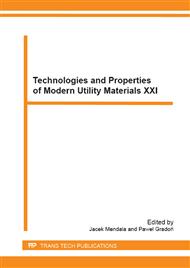p.141
p.145
p.151
p.157
p.163
p.167
p.175
p.179
p.183
Resistance to Electrochemical Corrosion under Conditions of Sterilisation of Guide Wires Used in Endourological Treatment
Abstract:
The influence of surface modification and steam sterilisation process on the corrosion characteristics of wires made of X10CrNi18-8 steel used for production of guide wires in endourological treatment was analysed in the study. Corrosion tests were made in artificial urine solution with application of electrochemical testing system VoltaLab PGP201. Resistance to pitting corrosion was evaluated on the ground of registered anodic polarisation curves by means of potentiodynamic method. The tests comprised wires with surface that was ground, electrochemically polished and chemically passivated. Steam sterilisation was performed in autoclave Basic Plus by Mocom. The tests proved that surface modification improved corrosion characteristics of the wire to a great extent. The best corrosion resistance in artificial urine was observed in wire whose surface was successively ground, polished and chemically passivated. It was also proved that chemical passivation process has a favourable impact on corrosion resistance improvement under sterilisation conditions.
Info:
Periodical:
Pages:
163-166
Citation:
Online since:
December 2013
Authors:
Price:
Сopyright:
© 2014 Trans Tech Publications Ltd. All Rights Reserved
Share:
Citation:


